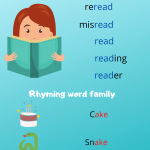Using Descriptive Teaching to Support the Learning of Communicators
 We want AAC users to have access to a wide range of vocabulary so that their communication is not inhibited and their learning is not affected. From science to social studies, children may come across several new terms throughout the school year. But programming all the content vocabulary into their AAC systems can be challenging. The Descriptive Model invented by Gail Tatenhove provides a way for teachers to impart classroom instruction in a way that allows use of core vocabulary that is already programmed into the communicator’s AAC system.
We want AAC users to have access to a wide range of vocabulary so that their communication is not inhibited and their learning is not affected. From science to social studies, children may come across several new terms throughout the school year. But programming all the content vocabulary into their AAC systems can be challenging. The Descriptive Model invented by Gail Tatenhove provides a way for teachers to impart classroom instruction in a way that allows use of core vocabulary that is already programmed into the communicator’s AAC system.
Explaining Descriptive Teaching
“Using a descriptive style, the teacher mentions and references the context-specific words, then teaches concepts behind the words using high frequency, re-usable, common words” (Van Tatenhove 2009). The teachers explain a term to be taught using common words that they know are already in the communicator’s AAC System. This is in contrast to the referential style of teaching which involves the teacher asking close-ended questions, which the communicator may able to answer only if they have access to the corresponding vocabulary.
Descriptive vs Referential Teaching
In Referential teaching, the focus is on memorization of terms and their definitions. This gives little scope for creative thinking and participation by learners with special needs. Descriptive teaching, on the other hand, uses primarily core words. Since core words comprise about 80% of the words we use in everyday life and can be used across different contexts, communicators typically have them already programmed in their AAC systems. This gives communicators an opportunity to learn using words they are familiar with.
Let’s look at a few examples of descriptive and referential teaching:

Why use Descriptive Teaching?
Imagine having to include every mathematical or scientific or geographical term that the child is learning about. It can mean an enormous amount of effort from the professional which can be well spent on helping the child gain a deeper understanding of the concept. Adding new vocabulary also means that the communicator has to remember how to navigate to the respective folder. This additional cognitive load can potentially slow down the communicator’s learning.
Descriptive teaching allows children to focus on the concepts being taught rather than expending their energy on finding the right vocabulary in their AAC systems. It also allows them to interact with their peers and teachers, and take part in academic discussions in both inclusive and special education classrooms.
Things to Keep in Mind for Descriptive Teaching to Work
The successful implementation of the Descriptive Teaching model would need a collaborative effort from teachers, speech language pathologists, and parents. The teachers, especially, can benefit from having a list of words programmed into a child’s AAC system and must be aware of any new words that are added. This will help them tailor their instruction and modify their questions accordingly.
For example, the teacher can explain an earthquake as ‘shaking of ground’. But if they learn that the word ‘sudden’ has been newly added to the child’s AAC system, the teacher can explain it better as ‘ a sudden shaking of ground’.
Earthquake: sudden shaking of ground
Similarly, the teacher can explain tornadoes as ‘strong winds’. But if the child had the word ‘dangerous’ in their AAC system, the teacher can say ‘strong, dangerous winds’ and help the child get a more precise definition.
Tornadoes: strong, dangerous winds
Communicators with special needs may require support to keep up with their peers in schools. When teachers use the descriptive method and adapt classroom instruction, children get a chance to exhibit their competence and realize their potential.
Subscribe to the Avaz Newsletter
Join 4000+ fellow readers! Get latest articles straight to your inbox. Enter your email address below:
Popular Articles
- Building Literacy: Teaching Grammar to AAC Users
- Expansion of Language: Supporting AAC Learner’s Progress
- Avaz User Stories and Videos
- Avaz Joyful Reading: Resources for Shared Reading
- AAC Resources: Games, Activities and Communication Opportunities
- Avaz AAC User Stories: Why Nishant and his AAC System are Inseparable
- Downloadable Low Tech Communication Boards
- Get the Better of Reading Difficulties with MDA Avaz Reader
- AAC Apps for Adults with Acquired Communication Disorders
- Teletherapy: A smart way to facilitate remote speech therapy for adults and children
